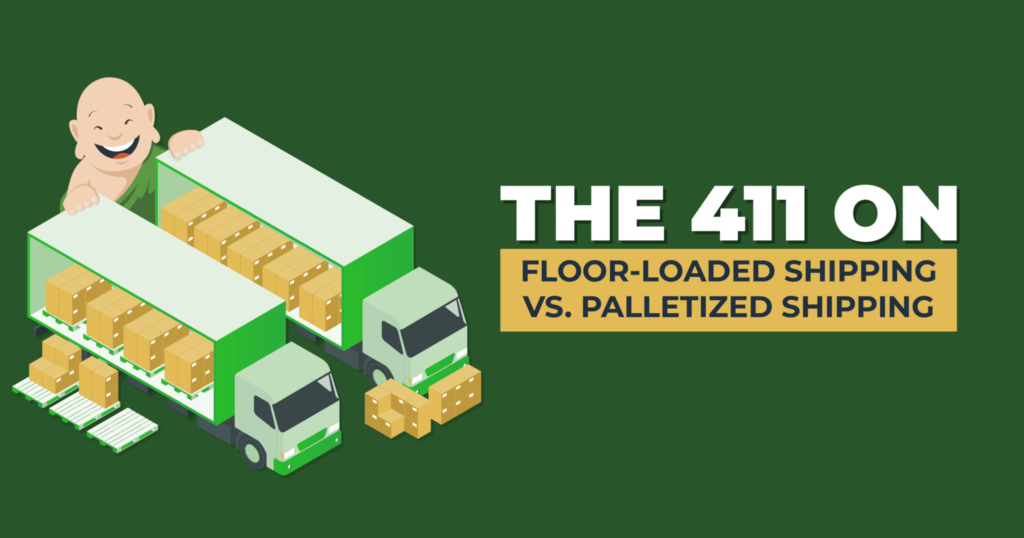Freight shipping can be frightening. In fact, worrying about your products arriving safe and sound to their destinations—whether they be residential doorstep or commercial—is one of the most stressful aspects of online entrepreneurship.
Luckily, knowledge is power, and the more you know about what goes on inside a shipping container, the better you’ll be at making informed decisions that are tailored to your individual needs. So let’s talk floor-loaded and palletized shipping, their pros and cons, and how to choose between the two!
What Is Floor-Loaded Shipping?
Have you ever played Tetris? If so, that’s pretty much what floor-loaded shipping is. Also known as floor stacking, this is a packing method that loads products directly onto the floor of a shipping container until it’s completely full.
What Is Palletized Shipping?
With palletized shipping, products are secured to a pallet (using metal straps or plastic shrink wrap) before they’re loaded into a shipping container.
Choosing Between Floor-Loaded Shipping and Palletized Shipping
Like with most aspects of fulfillment, choosing between floor-loaded and palletized shipping really comes down to what works best for your type of ecommerce business. And as you grow, it’s likely that your strategy will evolve to keep up with changes in your customer base and product offerings, so it’s best to always stay flexible. Now that we’ve defined floor-loaded and palletized shipping, let’s explore their specifics further.
Floor-Loaded Shipping
For bulky items like furniture, rugs, and tires, floor-loaded shipping is your go-to. Finding pallets that fit these products is not only difficult but also typically unnecessary due to their sheer size. However, just because certain products are sturdier doesn’t make them impervious to the elements or prolonged mishandling. Sure, the average rug can take a little scuffling, but the same might not hold true for grandma’s antique dresser, and neither will hold up particularly well to water damage. And when it comes to jewelry or smaller goods against the elements and mishandling—fuhgeddaboudit!
In terms of pricing, floor-loaded has lower associated freight costs because the entire container is utilized to load items whereas with palletized shipping you also have to pay for the pallets, and as a result the space they take up. It’s not a win-win though. You need to consider the costs of packing and unpacking shipments from floor-loaded containers, which need to be done by hand before being stored in a warehouse or fulfillment center. When you are determining if floor-loaded shipping is right for your ecommerce business, we’d advise a cost analysis that compares time and labor costs against savings from not having to purchase pallets.
Palletized Shipping
Palletized shipping is a great all-around option, especially suitable for delicate and/or fragile items. It makes up for all the cons of floor-loaded shipping, and then some. Since pallets are standardized in size, there’s no need for crazy calculations that aim to fill up every inch of space available. Pallets have standardized freight structuring designed for movability, which makes them easier to strategically place and relocate.
Additionally, palletized shipping is preferred by fulfillment centers and Amazon FBA. In fact, any box that is at least 50 lbs must be palletized per Amazon’s FBA contract. But of course, because of the added materials, palletized shipping tends to be pricier than floor-loaded shipping.
Best Practices for Floor-Loaded and Palletized Shipping
If you’re an ecommerce business that utilizes a 3PL’s order fulfillment services, you’re not involved with any freight shipping in a hands-on way. That being said, it’s still a good idea to understand the dos and don’ts of floor-loaded and palletized shipping, especially if you’re communicating with a manufacturer overseas about how to handle your precious products.
Best Practices for Floor-Loaded Shipping
- Keep items in place with straps and/or bars to avoid damage due to shifting.
- Always put heavier items at the bottom and lighter items on top.
- Set up shipments strategically (maybe using a software assist) to maximize the space available, reducing the chance of damage and overweight container fees.
Best Practices for Palletized Shipping
- Like with floor-loaded shipping, try to place all heavier items at the bottom to prevent damage.
- Make sure everything is centered so nothing tips or slips in transit.
- Stack products as close together as possible to avoid gaps.
- Ensure that pallets are not overflowing past pallet edges.
- Try to keep loads square and even.
- Use plastic to securely and tightly wrap each load to minimize risk of damage.
- Don’t include any empty boxes, as they can flatten in transit. If you have to include boxes that don’t carry product as a means to support the shape of the overall pallet shipment, pack them tightly with infill or sturdy dunnage materials to avoid box collapse.
No matter which method you opt for, the devil is always in the details. A single shipment could be worth hundreds of thousands of dollars, so any carelessness or improper handling is just not an option. Luckily, when you work with 3PL professionals who have a lot of experience in freight, your ecommerce business has its best chance to avoid shipping snafus or damage debacles.
Other Shipping Considerations
If you’re not working with a 3PL (and we’ll get into why you should in just a moment), and are freight shipping things yourself, keep in mind that both UPS and FedEx have shipping restrictions within the US. Essentially, unless you use their in-house services, they won’t pick up your pallets. FedEx Freight has also made palletized shipping a requirement. UPS will accept your ecommerce business’s unpalletized shipment, but only if you use their in-house service.
FTL vs. LTL
If we’re talking ship, FTL (full truckload) and LTL (less-than-truckload) are two terms you’ll inevitably hear. Technically, floor loading can only work in an FTL setting, while pallets can work for both. Need to ship freight but don’t have enough for a full truck? Then you’ll be shipping LTL.
Shipping with a 3PL
Whether you’re a big-box retailer or a mom-and-pop shop, freight shipping will always be a part of your ecommerce business fulfillment strategy. In the beginning, handling it all yourself could very well be the smartest choice, but, as you grow and scale, working with a 3PL becomes a true necessity.
While the physical resources of a fulfillment center are truly beneficial—among other things, a fulfillment center will receive, scan, and organize inbound inventory—being able to rely on a competent team that’s well-versed in freight will practically pay for itself. 3PLs can help battle freight misclassification and reweighing charges that plague even the best-intentioned ecommerce business owners.
If you’re considering working with a 3PL to coordinate your freight shipping, consider the following three questions:
1.) Are there any “musts” when it comes to shipping your products, like including ice packs or bubble wrap?
2.) Have you experienced any issues with shipping in the past? What/who were the culprits?
3.) Once your products leave your fulfillment center, where are they going? This is important because bulk shipments to residential areas will likely experience certain issues (like a lack of loading docks) that aren’t issues for commercial spaces.
Get the Weight of Freight off Your Shoulders
If you’re serious about taking your business to the next level and want to avoid logistics headaches as much as possible (and boy, those are painful), outsourcing to a 3PL fulfillment center is the way to go. In general, if you want a helping hand with freight shipping, ecommerce business fulfillment, and beyond, contact ShipMonk today for a quote or 3PL software demo to see first-hand how you can leverage our powerful fulfillment technology and expertise for ecommerce growth.





